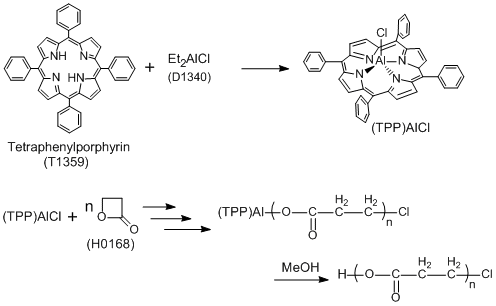Published TCIMAIL newest issue No.197
Maximum quantity allowed is 999
Merci de sélectionner la quantité
CAS RN: 917-23-7 | Numéro de produit: T1359
Tetraphenylporphyrin (Chlorin free)

Pureté: >98.0%(HPLC)
Synonymes
- Tetraphenylporphine (Chlorin free)
- TPP (Chlorin free)
Documents de produit:
| Taille | Prix unitaire | Belgique | Japon * | Quantité |
|---|---|---|---|---|
| 1G |
€132.00
|
12 | ≥40 |
|
*Le délai de livraison pour des produits disponibles en stock en Belgique est 1 à 2 jours
*Le délai de livraison pour des produits disponibles en stock en Japon est 1 à 2 semaines (sauf des produits réglementés et des envois avec de la glace carbonique)
| Numéro de produit | T1359 |
| Pureté / Méthode d'analyse | >98.0%(HPLC) |
| Formule moléculaire / poids moléculaire | C__4__4H__3__0N__4 = 614.75 |
| Etat physique (20 ° C) | Solid |
| Condition de stockage | Room Temperature (Recommended in a cool and dark place, <15°C) |
| Stocker sous gaz inerte | Store under inert gas |
| Condition à éviter | Air Sensitive |
| Emballage Et Conteneur | 1G-Glass Bottle with Plastic Insert (Voir l'image) |
| CAS RN | 917-23-7 |
| Numéro de registre de Reaxys | 379542 |
| Identifiant de la substance PubChem | 87577126 |
| Numéro MDL | MFCD00011680 |
Spécifications
| Appearance | Orange to Brown to Dark purple powder to crystal |
| Purity(HPLC) | min. 98.0 area% |
| Tetraphenylchlorin | max. 0.5 % |
| NMR | confirm to structure |
Propriétés
SGH
Lois connexes:
| Numéros CE | 213-025-9 |
Informations de transport:
| N ° SH (import / export) (TCI-E) | 2933998090 |
Application
Molecular-weight Controlled Polymerization Using Aluminum-porphyrins

Typical Procedure:
The flask containing tetraphenylporphine ((TPP)H2)(1.0 mmol) is purged with dry N2, and then CH2Cl2 (20 mL) is introduced to dissolve (TPP)H2. To this solution is added Et2AlCl (1.2 mmol, 20% excess to (TPP)H2) by syringe under a N2 atmosphere at room temperature with stirring. After a definite time, the volatile materials are removed from this reaction mixture under reduced pressure to give a purple solid (TPP)AlCl) with metallic luster. CH2Cl2 (20 mL) is introduced to this flask to dissolve the product, to obtain the catalyst solution.
To the catalyst solution ((TPP)AlCl 20.4 mM) with stirring is added β-propiolactone (6.12 mol) by syringe at room temperature in a N2 atmosphere. After a definite time, a large excess of methanol is added to the reaction mixture to stop the polymerization, and then volatile materials are removed under reduced pressure to leave the product. The polymer is isolated as a slightly yellow-green powder by precipitation of the product from chloroform/methanol after shaking the chloroform solution with dilute hydrochloric acid.
The gel permeation chromatogram (GPC) of the resulting polymer shows the weight average molecular weight to the number average molecular weight (Mw/Mn) : 1.26 and the number average molecular weight (Mn) : 3500.
The flask containing tetraphenylporphine ((TPP)H2)(1.0 mmol) is purged with dry N2, and then CH2Cl2 (20 mL) is introduced to dissolve (TPP)H2. To this solution is added Et2AlCl (1.2 mmol, 20% excess to (TPP)H2) by syringe under a N2 atmosphere at room temperature with stirring. After a definite time, the volatile materials are removed from this reaction mixture under reduced pressure to give a purple solid (TPP)AlCl) with metallic luster. CH2Cl2 (20 mL) is introduced to this flask to dissolve the product, to obtain the catalyst solution.
To the catalyst solution ((TPP)AlCl 20.4 mM) with stirring is added β-propiolactone (6.12 mol) by syringe at room temperature in a N2 atmosphere. After a definite time, a large excess of methanol is added to the reaction mixture to stop the polymerization, and then volatile materials are removed under reduced pressure to leave the product. The polymer is isolated as a slightly yellow-green powder by precipitation of the product from chloroform/methanol after shaking the chloroform solution with dilute hydrochloric acid.
The gel permeation chromatogram (GPC) of the resulting polymer shows the weight average molecular weight to the number average molecular weight (Mw/Mn) : 1.26 and the number average molecular weight (Mn) : 3500.
References
- T. Aida, R. Mizuta, Y. Yoshida, S. Inoue, Makromol. Chem. 1981, 182, 1073.

- T. Yasuda, T. Aida, S. Inoue, Macromolecules 1984, 17, 2217.

- S. Asano, T. Aida, S. Inoue, J. Chem. Soc. Chem. Commun. 1985, 1148.

- Y. Watanabe, T. Yasuda, T. Aida, S. Inoue, Macromolecules 1992, 25, 1396.

- M. Komatsu, T Aida, S. Inoue, J. Am. Chem. Soc. 1991, 113, 8492.

- H. Sugimoto, M. Kuroki, T.Watanabe, C. Kawamura, T. Aida, S. Inoue, Macromolecules 1993, 26, 3403.

PubMed Litterature
Articles / Brochures
Documents de produit (Note : Pour certains produits, les tableaux analytiques ne sont pas disponibles.)
Fiche de sécurité (FDS)
S'il vous plaît sélectionnez la langue.
La FDS demandée n'est pas disponible.
Nous contacter pour plus d'informations.
Spécifications
CoA et autres Certificats
Veuillez remplir le numéro de lot
Le numéro de lot saisi est incorrect. Veuillez saisir uniquement 4-5 caractères alphanumériques avant le trait d'union.
Exemple de CoA
Il s'agit d'un échantillon CoA qui peut ne pas représenter un lot récemment fabriqué du produit.
Un échantillon CoA pour ce produit n'est pas disponible pour le moment.
Graphiques analytiques
Veuillez remplir le numéro de lot
Le numéro de lot saisi est incorrect. Veuillez saisir uniquement 4-5 caractères alphanumériques avant le trait d'union.
Le tableau analytique demandé n'est pas disponible. Nous sommes désolés pour ce désagrément.






![TPP (=Tetraphenylporphyrin) [Ultra-high sensitive spectrophotometric reagent for Cu] TPP (=Tetraphenylporphyrin) [Ultra-high sensitive spectrophotometric reagent for Cu]](/medias/A5012.jpg?context=bWFzdGVyfHJvb3R8NDUyNTN8aW1hZ2UvanBlZ3xhREJtTDJoaU1DODRPVEk0TlRFeU1UZ3dNalUwTDBFMU1ERXlMbXB3Wnd8MmU4MjU4OThkYTY4ODU5YzFjZmE4YTBjMjQ3NjkwM2UxYTNmNTllN2RkMzMyZDFkODJjOGY3ZTQwZmFhNjk1OA)